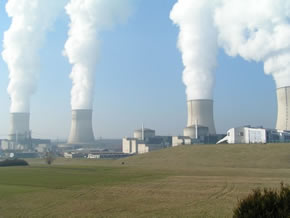Louis-Gilles Francoeur
Le Devoir (Canada)
Le 31-10-2008

© DR
Le secteur privé ne se lance pas dans
le nucléaire parce que la rentabilité de cette filière
est chancelante, pour ne pas dire déficiente sans injection de fonds
publics substantiels, directs ou indirects, au moyen de la fiscalité.
C'est ce qu'affirme une récente analyse du Earth Policy Institute,
présidé par Lester R. Brown, qui s'intitule ''The Flawed
Economics of Nuclear Power''.
Dans les dernières années, explique
Lester Brown, l'industrie nucléaire a misé sur les préoccupations
du public en matière de changements climatiques pour défendre
le retour de la filière. Même si les ténors de cette
industrie ont convaincu quelques leaders politiques qu'il s'agissait d'une
bonne idée, il y a peu d'indices qui démontrent que des capitaux
privés sont investis massivement dans des centrales nucléaires
pour vendre de l'électricité sur un marché libre.
Lester Brown explique ce peu d'enthousiasme
des investisseurs par une analyse d'un autre auteur célèbre,
Amory B. Lovins, qui établit le prix de l'électricité
produite à partir d'une centrale nucléaire à 14 ¢US
du kilowattheure, comparativement à 7 ¢US pour la même
énergie produite avec une éolienne. Cette comparaison englobe
le coût du carburant nucléaire, du capital, du fonctionnement,
de l'entretien, du transport et de la distribution de cette électricité.
Mais elle ne comprend pas le coût additionnel mais éventuellement
incontournable de l'élimination sécuritaire des déchets
radio-actifs, des assurances en responsabilité en cas d'accident
nucléaire et de la démolition des centrales, dont une bonne
partie des matériaux seront eux-mêmes radio-actifs pendant
des générations.
Les États-Unis produisent
101.000 MW avec les 104 réacteurs de
leur filière nucléaire. Ils prévoyaient investir en
2001 plus de 58 milliards pour construire le dépotoir nucléaire
de Yucca Mountain, en Utah, un coût qui a grimpé depuis à
96 milliards pour un projet disponible seulement en 2017. Jusqu'ici, 119
réacteurs ont cessé leurs activités mais sont entreposés
temporairement dans des endroits dont la sécurité est discutable.
En cas d'accident, chaque opérateur de centrale nucléaire
devra fournir 95,8 millions au pool de cette industrie, dont la couverture
totale d'assurance atteint 10 milliards. Tout excédent sera redonné
aux gouvernements et aux contribuables.
Présentement, 36 nouveaux réacteurs
sont en construction dans le monde, dont 31 en Europe et en Asie. Plusieurs
autres, comme ceux de la centrale de Gentilly au Québec, vont être
restaurés pour prolonger leur vie utile, une décision gouvernementale
soustraite à une évaluation environnementale indépendante
et à tout débat parlementaire.Louis-Gilles
Francoeur pour Le Devoir (Canada)
|
October 28, 2008 - 10
The Flawed Economics of Nuclear Power
http://www.earthpolicy.org/
Nous vous livrons l'introduction
et la conclusion de cette étude passionnante dont l'intégralité
est disponible ci-dessus
Copyright
© 2008 Earth Policy Institute
Lester R. Brown
Over the last few years the nuclear industry
has used concerns about climate change to argue for a nuclear revival.
Although industry representatives may have convinced some political leaders
that this is a good idea, there is little evidence of private capital investing
in nuclear plants in competitive electricity markets. The reason is simple:
nuclear power is uneconomical.
In an excellent recent analysis, "The Nuclear
Illusion," Amory B. Lovins and Imran Sheikh put the cost of electricity
from a new nuclear power plant at 14¢ per kilowatt hour and that from
a wind farm at 7¢ per kilowatt hour. This comparison includes the
costs of fuel, capital, operations and maintenance, and transmission and
distribution. It does not include the additional costs for nuclear of disposing
of waste, insuring plants against an accident, and decommissioning the
plants when they wear out. Given this huge gap, the so-called nuclear revival
can succeed only by unloading these costs onto taxpayers. If all the costs
of generating nuclear electricity are included in the price to consumers,
nuclear power is dead in the water.
To get a sense of the costs of nuclear waste
disposal, we need not look beyond the United States, which leads the world
with 101,000 megawatts of nuclear-generating capacity (compared with 63,000
megawatts in second-ranked France). The United States proposes to store
the radioactive waste from its 104 nuclear power reactors in the Yucca
Mountain nuclear waste repository, roughly 90 miles northwest of Las Vegas,
Nevada. The cost of this repository, originally estimated at $58 billion
in 2001, climbed to $96 billion by 2008. This comes to a staggering $923
million per reactor—almost $1 billion each—assuming no further repository
cost increases.
See
data !
(...)
Even if all reactors scheduled to come online
by 2015 make it, the projected closing of 93 nuclear reactors by then will
drop nuclear power generation roughly 10 percent below the current level.
Unless governments start routinely granting operating permits for reactors
more than 40 years old, a half-century of growth in world nuclear generating
capacity is about to be replaced by a long-term decline.
Despite all the industry hype about a nuclear
future, private investors are openly skeptical. In fact, while little private
capital is going into nuclear power, investors are pouring tens of billions
of dollars into wind farms each year. And while the world's nuclear generating
capacity is estimated to expand by only 1,000 megawatts this year, wind
generating capacity will likely grow by 30,000 megawatts. In addition,
solar cell installations and the construction of solar thermal and geothermal
power plants are all growing by leaps and bounds.
The reason for this extraordinary gap between
the construction of nuclear power plants and wind farms is simple: wind
is much more attractive economically. Wind yields more energy, more jobs,
and more carbon reduction per dollar invested than nuclear. Though nuclear
power plants are still being built in some countries and governments are
talking them up in others, the reality is that we are entering the age
of wind, solar, and geothermal energy.
Listen/download
as mp3
Listen
to Press Teleconference |
